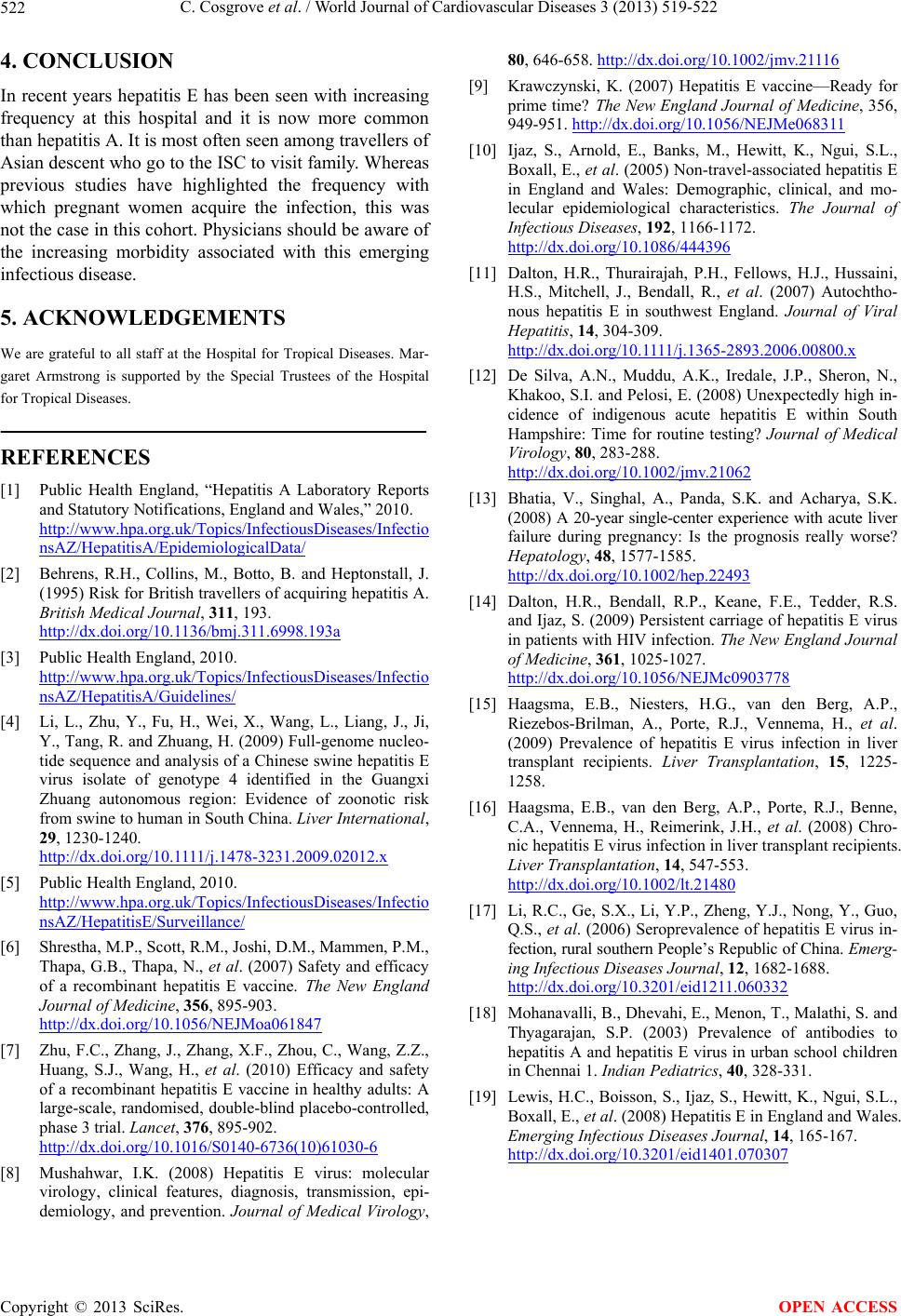
C. Cosgrove et al. / World Journal of Cardiovascular Diseases 3 (2013) 519-522
Copyright © 2013 SciRes.
522
4. CONCLUSION
OPEN ACCESS
In recent years hepatitis E has been seen with increasing
frequency at this hospital and it is now more common
than hepatitis A. It is most often seen among travellers of
Asian descent who go to the ISC to v isit family. Whereas
previous studies have highlighted the frequency with
which pregnant women acquire the infection, this was
not the case in this cohort. Physicians shou ld be aware of
the increasing morbidity associated with this emerging
infectious disease.
5. ACKNOWLEDGEMENTS
We are grateful to all staff at the Hospital for Tropical Diseases. Mar-
garet Armstrong is supported by the Special Trustees of the Hospital
for Tropical Diseases.
REFERENCES
[1] Public Health England, “Hepatitis A Laboratory Reports
and Statutory Notifications, England and Wales,” 2010.
http://www.hpa.org.uk/Topics/InfectiousDiseases/Infectio
nsAZ/HepatitisA/EpidemiologicalData/
[2] Behrens, R.H., Collins, M., Botto, B. and Heptonstall, J.
(1995) Risk for British travellers of acquiring hepatitis A.
British Medical Journal, 311, 193.
http://dx.doi.org/10.1136/bmj.311.6998.193a
[3] Public Health England, 2010.
http://www.hpa.org.uk/Topics/InfectiousDiseases/Infectio
nsAZ/HepatitisA/Guidelines/
[4] Li, L., Zhu, Y., Fu, H., Wei, X., Wang, L., Liang, J., Ji,
Y., Tang, R. and Zhuang, H. (2009) Full-genome nucleo-
tide sequence and analysis of a Chinese swine hepatitis E
virus isolate of genotype 4 identified in the Guangxi
Zhuang autonomous region: Evidence of zoonotic risk
from swine to human in South China. Liver International,
29, 1230-1240.
h tt p :/ /dx .doi .org/1 0 .1111 /j .1478-3231.2009.02012.x
[5] Public Health England, 2010.
http://www.hpa.org.uk/Topics/InfectiousDiseases/Infectio
nsAZ/HepatitisE/Surveillance/
[6] Shrestha, M.P., Scott, R. M., Joshi, D.M., Mammen, P.M.,
Thapa, G.B., Thapa, N., et al. (2007) Safety and efficacy
of a recombinant hepatitis E vaccine. The New England
Journal of Medicine, 356, 895-903.
http://dx.doi.org/10.1056/NEJMoa061847
[7] Zhu, F.C., Zhang, J., Zhang, X.F., Zhou, C., Wang, Z.Z.,
Huang, S.J., Wang, H., et al. (2010) Efficacy and safety
of a recombinant hepatitis E vaccine in healthy adults: A
large-scale, randomised, double-blind placebo-controlled,
phase 3 trial. Lancet, 376, 895-902.
http://dx.doi.org/10.1016/S0140-6736(10)61030-6
[8] Mushahwar, I.K. (2008) Hepatitis E virus: molecular
virology, clinical features, diagnosis, transmission, epi-
demiology, and prevention. Journal of Medical Virology,
80, 646-658. http://dx.doi.org/10.1002/jmv. 21116
[9] Krawczynski, K. (2007) Hepatitis E vaccine—Ready for
prime time? The New England Journal of Medicine, 356,
949-951. http://dx.doi.org/10.1056/NEJMe068311
[10] Ijaz, S., Arnold, E., Banks, M., Hewitt, K., Ngui, S.L.,
Boxall, E., et al. (2005) Non-travel-associated hepatitis E
in England and Wales: Demographic, clinical, and mo-
lecular epidemiological characteristics. The Journal of
Infectious Diseases, 192, 1166-1172.
http://dx.doi.org/10.1086/444396
[11] Dalton, H.R., Thurairajah, P.H., Fellows, H.J., Hussaini,
H.S., Mitchell, J., Bendall, R., et al. (2007) Autochtho-
nous hepatitis E in southwest England. Journal of Viral
Hepatitis, 14, 304-309.
h tt p :/ /dx .doi .org/1 0 .1111 /j .1365-2893.2006.00800.x
[12] De Silva, A.N., Muddu, A.K., Iredale, J.P., Sheron, N.,
Khakoo, S.I. and Pelosi, E. (2008) Unexpectedly high in-
cidence of indigenous acute hepatitis E within South
Hampshire: Time for routine testing? Journal of Medical
Virology, 80, 283-288.
http://dx.doi.org/10.1002/jmv.21062
[13] Bhatia, V., Singhal, A., Panda, S.K. and Acharya, S.K.
(2008) A 20-year single-center experience with acute liver
failure during pregnancy: Is the prognosis really worse?
Hepatology, 48, 1577-1585.
http://dx.doi.org/10.1002/hep.22493
[14] Dalton, H.R., Bendall, R.P., Keane, F.E., Tedder, R.S.
and Ijaz, S. (2009) Persistent carriage of hepatitis E virus
in patients with HIV infection. The New England Journal
of Medici ne, 361, 1025-1027.
http://dx.doi.org/10.1056/NEJMc0903778
[15] Haagsma, E.B., Niesters, H.G., van den Berg, A.P.,
Riezebos-Brilman, A., Porte, R.J., Vennema, H., et al.
(2009) Prevalence of hepatitis E virus infection in liver
transplant recipients. Liver Transplantation, 15, 1225-
1258.
[16] Haagsma, E.B., van den Berg, A.P., Porte, R.J., Benne,
C.A., Vennema, H., Reimerink, J.H., et al. (2008) Chro-
nic hepatitis E virus infection in liver transplant recipients.
Liver Transplantation, 14, 547-553.
http://dx.doi.org/10.1002/lt.21480
[17] Li, R.C., Ge, S.X., Li, Y.P., Zheng, Y.J., Nong, Y., Guo,
Q.S., et al. (2006) Seroprevalence of hepatitis E virus in-
fection, rural southern People’s Re public of China. Emerg-
ing Infectious Diseases Journal, 12, 1682-1688.
http://dx.doi.org/10.3201/eid1211.060332
[18] Mohanavalli, B., Dhevahi, E., Menon, T., Malathi, S. and
Thyagarajan, S.P. (2003) Prevalence of antibodies to
hepatitis A and hepatitis E virus in urban school children
in Chennai 1. Indian Pediatrics, 40, 328-331.
[19] Lewis, H.C., Boisson, S., Ijaz, S., Hewitt, K., Ngui, S.L.,
Boxall, E., et al. (2008) Hepatitis E in England and Wales.
Emerging Infectious Diseases Journal, 14, 165-167.
http://dx.doi.org/10.3201/eid1401.070307